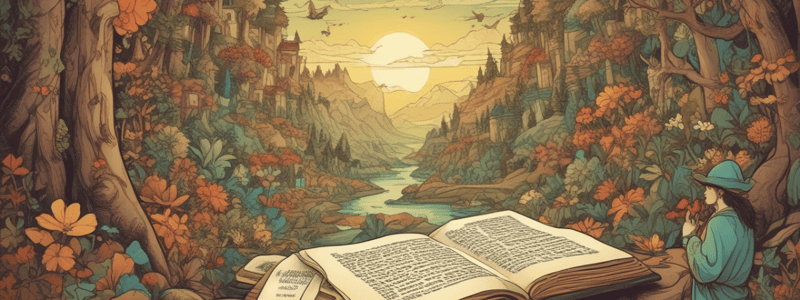Podcast
Questions and Answers
What is the primary purpose of fiction writing?
What is the primary purpose of fiction writing?
- To inform readers about real events
- To provide step-by-step instructions
- To express oneself through make-believe stories (correct)
- To persuade readers to a particular point of view
Which of the following is a characteristic of nonfiction writing?
Which of the following is a characteristic of nonfiction writing?
- It is entirely based on imagination
- It is only used in poetry and novels
- It is often informative and based on facts (correct)
- It is always about real people and events
What is a key difference between fiction and nonfiction?
What is a key difference between fiction and nonfiction?
- The genre of writing
- The truthfulness of the content (correct)
- The level of creativity involved
- The tone of the writing
Which type of writing can include textbooks, reference materials, and documentaries?
Which type of writing can include textbooks, reference materials, and documentaries?
What is a similarity between fiction and nonfiction writing?
What is a similarity between fiction and nonfiction writing?
Which of the following is an example of fiction?
Which of the following is an example of fiction?
What is a common trait of fiction and nonfiction writing that makes them resemble each other?
What is a common trait of fiction and nonfiction writing that makes them resemble each other?
What is the main difference between fiction and nonfiction stories?
What is the main difference between fiction and nonfiction stories?
What type of writing is characterized by being informative and based on facts?
What type of writing is characterized by being informative and based on facts?
What is a common feature of fiction stories that distinguishes them from nonfiction?
What is a common feature of fiction stories that distinguishes them from nonfiction?
What is a type of nonfiction writing that provides information or instruction on a particular topic?
What is a type of nonfiction writing that provides information or instruction on a particular topic?
Study Notes
Writing Styles
- Writing is a way of expressing oneself through words.
Fiction
- Fiction books are made-up by the author and are not true.
- Examples of fiction include:
- Poems
- Stories
- Novels
- Plays
- Movies
Nonfiction
- Nonfiction books are about real things, people, places, or events.
- Examples of nonfiction include:
- Textbooks
- Reference materials
- Newspapers
- Legal documents
- Documentaries
- Biographies
Similarities between Fiction and Nonfiction
- Both can resemble real-life situations.
- Both can be based on the truth.
Differences between Fiction and Nonfiction
- Fiction:
- Can be realistic and contain facts, but the story is not true.
- Is make-believe.
- Nonfiction:
- Is true and based on facts.
- Is informative and about real events or people.
Writing Styles
- Writing is a way of expressing oneself through words.
Fiction
- Fiction books are made-up by the author and are not true.
- Examples of fiction include:
- Poems
- Stories
- Novels
- Plays
- Movies
Nonfiction
- Nonfiction books are about real things, people, places, or events.
- Examples of nonfiction include:
- Textbooks
- Reference materials
- Newspapers
- Legal documents
- Documentaries
- Biographies
Similarities between Fiction and Nonfiction
- Both can resemble real-life situations.
- Both can be based on the truth.
Differences between Fiction and Nonfiction
- Fiction:
- Can be realistic and contain facts, but the story is not true.
- Is make-believe.
- Nonfiction:
- Is true and based on facts.
- Is informative and about real events or people.
Studying That Suits You
Use AI to generate personalized quizzes and flashcards to suit your learning preferences.
Related Documents
Description
Learn about the basics of fiction and nonfiction writing, including examples of each and their differences. This presentation covers various forms of writing, including novels, poems, stories, plays, and more.




